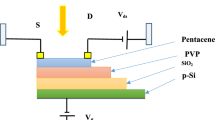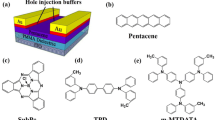Abstract
In this paper, the pentacene-based organic field-effect transistors (OFETs) with poly(methyl methacrylate) (PMMA) as gate dielectrics were fabricated, and the effects of gate dielectric thickness and semiconductor thickness on the device performance were investigated. The optimal PMMA thickness is in the range of 350–400 nm to sustain a considerable current density and stable performance. The device performance depends on the thicknesses of the active layer non-monotonically, which can be explained by the morphology of the pentacene film and the position of the conducting channel in the active layer. The device with a pentacene thickness of 50 nm shows the best performance, which has a maximum hole mobility of 1.12 cm2/V · s. In addition, the introduction of a thin layer of tris-(8-hydroxyquinolinato) aluminum (Alq3) to the OFETs as a light-emitting material greatly decreases the device performance.
Similar content being viewed by others
References
Barbe D F, Westgate C R. Surface state parameters of metal-free phthalocyanine single crystals. J Phys Chem Solids, 1970, 31: 2679–2687
Tsumura A, Koezuka H, Ando T. Macromolecular electronic device: Field-effect transistor with a polythiophene thin film. Appl Phys Lett, 1986, 49: 1210–1212
Horowitz G. Organic field-effect transistors. Adv Mater, 1998, 10: 365–377
Estrada M, Mej A I, Cerdeira A, et al. Mobility model for compact device modeling of OTFTs made with different materials. Solid-State Electronics, 2008, 52: 787–794
Lin Y Y, Gundlach D J, Nelson S F, et al. Stacked pentacene layer organic thin-film transistors with improved characteristics. Electron Device Lett IEEE, 1997, 18: 606–608
Kanicki J, Libsch F R, Griffith J, et al. Performance of thin hydrogenated amorphous silicon thin-film transistors. J Appl Phys, 1991, 69: 2339–2345
Klauk H, Halik M, Zschieschang U, et al. High-mobility polymer gate dielectric pentacene thin film transistors. J Appl Phys, 2002, 92: 5259–5283
Cheng J-A, Chuang C-S, Chang M-N, et al. Enhanced field-effect mobility in pentacene based organic thin-film transistors on polyacrylates. J Appl Phys, 2009, 105: 064506
Huang T S, Su Y K, Wang P C. Study of organic thin film transistor with polymethylmethacrylate as a dielectric layer. Appl Phys Lett, 2007, 91: 092116–092118
Hepp A, Heil H, Weise W, et al. Light-emitting field-effect transistor based on a tetracene thin film. Phys Rev Lett, 2003, 91: 157406
Cicoira F, Santato C. Organic light emitting field effect transistors: advances and perspectives. Adv Funct Mater, 2007, 17: 3421–3434
Muccini M. A bright future for organic field-effect transistors. Nature Mater, 2006, 5: 605–613
Di C A, Yu G, Liu Y Q, et al. Organic light-emitting transistors containing a laterally arranged heterojunction. Adv Funct Mater, 2007, 17: 1567–1573
Rost C, Karg S, Riess W, et al. Ambipolar light-emitting organic field-effect transistor. Appl Phys Lett, 2004, 85: 1613–1615
Swensen J S, Soci C, Heeger A J. Light emission from an ambipolar semiconducting polymer field-effect transistor. Appl Phys Lett, 2005, 87: 253511–253513
Maiorano V, Bramanti A, Carallo S, et al. Organic light emitting field effect transistors based on an ambipolar p-i-n layered structure. Appl Phys Lett, 2010, 96: 133305–133307
Wang J, Yan X, Xu Y, et al. Organic thin-film transistors having inorganic/organic double gate insulators. Appl Phys Lett, 2004, 85: 5424–5426
Hoshino S, Kamata T, Yase K. Effect of active layer thickness on device properties of organic thin-film transistors based on Cu(II) phthalocyanine. J App Phys, 2002, 92: 6028–6032
Ruiz R, Papadimitratos A, Mayer A C, et al. Thickness dependence of mobility in pentacene thin-film transistors. Adv Mater, 2005, 17: 1795–1798
Dinelli F, Murgia M, Levy P, et al. Spatially correlated charge transport in organic thin film transistors. Phys Rev Lett, 2004, 92: 116802
Author information
Authors and Affiliations
Corresponding author
Rights and permissions
About this article
Cite this article
Yi, R., Lou, Z., Hu, Y. et al. Effects of gate dielectric thickness and semiconductor thickness on device performance of organic field-effect transistors based on pentacene. Sci. China Technol. Sci. 57, 1142–1146 (2014). https://doi.org/10.1007/s11431-014-5540-2
Received:
Accepted:
Published:
Issue Date:
DOI: https://doi.org/10.1007/s11431-014-5540-2




